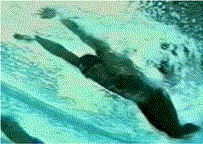HOW CHAMPIONS DO IT
Researched, produced, and prepared by Brent S. Rushall,
Ph.D., R.Psy.

ANDREI SERDINOV AT 25 m OF HIS WORLD RECORD SEMI-FINAL 100 m BUTTERFLY RACE AT THE 2003 WORLD CHAMPIONSHIPS IN BARCELONA
The time between each frame is not known. Andrei Serdinov's time was 51.76, a new world record that was broken in the next semi-final race.
This stroke analysis includes a moving sequence in real time, a moving sequence where each frame is displayed for .5 of a second, and still frames.
The following image sequence is in real time. It will play through 10 times and then stop. To repeat the sequence, click the browser's "refresh" or "reload" button.

The following image sequence shows each frame for half a second. It will play through 10 times and then stop. To repeat the sequence, click the browser's "refresh" or "reload" button.

At the end of the following narrative, each frame is illustrated in detail in a sequential collage.
Notable Features
Because of the unusual angle of this film series, a complete frame by frame analysis is not provided.
- Frames #1-6: The hands enter with flat hands. In frame #1 it appears the swimmer is preparing for a "direct" repositioning of the arms before developing propulsion. However in frames #2-4, the arms slide sideways defeating the initial impression. Frame #5 exhibits a peculiar rotation of the wrists to face further outward as the elbows flex. Frame #6 shows the initiation of propulsion which is a small force component of a much larger vertical force component. The drag pocket created by the arm movement is obvious off the back of the hand-forearm of the right arm and the left hand.
- Frames #7-11: Both arms propel the body forward. However, not all the force created is horizontal. There exists a considerable vertical force component in the early pull, which is used to raise the head and shoulders out of the water. At the end of the pull, there is still a reduced vertical force component, which is sufficient to keep the mouth above the surface so that breathing can occur outside the effort phase of the stroke (at completion of the pull). The force created by both arms is the largest competitive swimming. The size of the drag pocket turbulence in frame #8 illustrates this phenomenon. The length of Andrei Serdinov's propulsive phase is more than most would expect. He continues to apply force until the very end when the arms "round-out", which signals the beginning of the recovery.
- Frames #12-17: The recovery's main feature is the body continuing in a flat position during most of the arm sweep. It is impossible to keep the body flat when the arms round into and out of the water. Those actions cause the shoulders to be depressed into the water as a reaction to their vertical force components.
Although Andrei Serdinov is one of the best butterfly swimmers in the world there is still room for improvement. If he altered his stroke to remove the repositioning of the arms outward (Frames #2-5), an inertial lag would be eliminated. The resulting greater proportion of productive propulsion, which is a feature that appears to be entering into butterfly techniques at this time, should result in an improved time.

Return to Table of Contents for this section.






